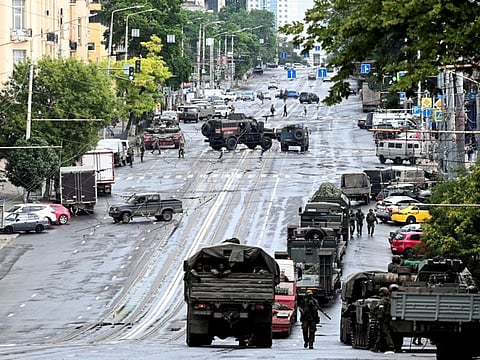Rostov-on-Don: Why did Wagner mercenaries target this Russian city?
Tanks and armed Wagner rebels deploy in southern Russia town, 100km from Ukraine border

Dubai: Rostov-on-Don is a port city located just over 100 kilometres from the Ukrainian border.
The city is home to the Russian southern military district command, whose 58th Combined Arms Army is fighting against Kyiv’s counteroffensive in southern Ukraine, according to the Institute for the Study of War (ISW) thinktank.
Rostov also houses the command centre for the Russian joint group of forces in Ukraine as a whole and is therefore a critical logistical hub for the Russian army.
Any threat to the Russian military’s presence there is likely to have ramifications on some critical aspects of the war effort, the ISW says.
The city was founded in 1749 as the customs post of Temernika, when the river mouth was still in Turkish hands. It then became a flourishing trade centre. Between 1761 and 1763 the fortress of St. Dmitry of Rostov was built there, and a town developed around it, near the Armenian settlement of Nakhichevan-na-Donu, which later merged with Rostov.
Also Read: What we know about Russia’s Wagner rebellion
In 1797 town status was granted, and in 1806 it was named Rostov-on-Don. Because of its key position as a transport centre and port, the town grew steadily with the 19th-century Russian colonisation and development of the north Caucasus region and conquest of the Transcaucasia, according to Encyclopædia Britannica.
Natural-gas pipeline connections
The Don River route to the interior was improved by the opening of the Volga-Don Shipping Canal in 1952, linking the town to the entire Volga basin; a dredged channel gives access to the sea. Rostov lies on road, rail, and oil and natural-gas pipeline connections between central European Russia and the Caucasus region. This nodal location and the nearness of the great Donets Coal Basin have led to major industrial development, especially in engineering.
Unlike other large Russian cities further from the front lines, Rostov-on-Don — with a population of just over one million people — has experienced the ripple effects of Russia’s large-scale military operation in Ukraine.
One person was killed in March at an FSB building fire in Rostov-on-Don and the Rostov region has also been targeted over recent months in several drone attacks.
Regional governor Vasily Golubev called on residents not to leave their homes unless absolutely necessary and said any planned mass gatherings in the city had been cancelled.
People asked stay home
He also asked the public not to use the M4 motorway - the main road connection between Moscow and southern Russia - as sections have been closed and large queues of cars have formed along it.
Golubev said public transport in the city was still functioning but routes had been changed to avoid the city centre.
“The situation that has arisen requires a maximum concentration of efforts to keep order,” he said on social media.
“Law enforcement agencies are doing everything necessary to ensure the security of our region’s residents.”
Earlier, the sound of ambulance and police sirens filled the air in Rostov-on-Don - a hub for Russia’s Ukraine campaign - where the rebellious Wagner mercenary force said it had taken over key facilities.
At a major intersection in the city centre, an armoured car with a machine gun and around a dozen men in military fatigues with silver armbands could be seen.
Armoured personnel carriers and tanks were positioned in other parts of the centre, including outside a toy shop and a circus, journalists in the city reported.
Passers-by stopped to look at the military vehicles, including transport trucks, and more armed men with silver armbands carrying rifles in resting positions.
Wagner chief Yevgeny Prigozhin has said his troops had taken control of Russia’s main military command centre for Ukraine operations as well as an airbase in the city, vowing to topple Moscow’s top military leaders.
He said he commanded around 25,000 fighters.
Sign up for the Daily Briefing
Get the latest news and updates straight to your inbox



